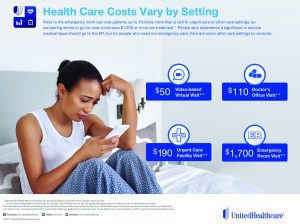 People who experience an injury or illness often have to decide where best to seek medical attention, with some patients often heading to the emergency room (ER). Because ERs prioritize life-threatening emergencies, patients who are experiencing non-emergencies often have to wait hours to be seen by a doctor.
People who experience an injury or illness often have to decide where best to seek medical attention, with some patients often heading to the emergency room (ER). Because ERs prioritize life-threatening emergencies, patients who are experiencing non-emergencies often have to wait hours to be seen by a doctor.
Visits to the emergency room can also cost patients up to 10-times more than a visit to urgent care or other care settings, so comparing where to go for care could save $1,500 or more per treatment. In fact, families could save $4.4 billion annually by choosing an urgent care, a doctor’s office or even a virtual environment – depending on the medical issue – instead of an ER when seeking non-emergency care, according to the National Institutes of Health.
People who experience a significant or serious medical issue should go to the ER, but for people who need non-emergency care, Dr. Christine Laramée, medical director, UnitedHealthcare of Central and North Florida, provides some tips to consider:
Know your options: There are several different care settings to consider depending on the nature or severity of your illness or injury:
– Emergency room: for serious or critical conditions that require immediate medical attention including persistent chest pains, broken bones and head or eye injuries;
– Urgent care center: for non-life-threatening injuries or illnesses that require immediate care, such as ear pain, persistent diarrhea, a minor sprain or shallow cut;
– Primary care physician: for wellness check-ups, diagnostics, management of long-term conditions and some urgent and non-urgent treatments;
– Virtual visits: for online access to a doctor for minor health needs or to obtain certain written prescriptions; and
– Convenience care clinic: for non-urgent medical conditions such as sprains, skin rashes, sore throats and upset stomachs, often staffed by nurse practitioners.
Understand your coverage: Read your health plan’s summary plan description to understand what is covered so you’re aware of potential out-of-pocket costs, including premiums, copayments, deductibles and co-insurance. Visit an online glossary to understand what those terms mean. According to a recent UnitedHealthcare study, just nine percent of Americans could successfully define all of these terms. Knowing this information can help prepare you to ask questions that may avoid surprises in your medical bills.
Comparison shop based on quality and cost. There are many online and mobile resources offering health care quality and cost information that enable people to comparison shop for health care as they would with other consumer products and services. Nearly one third of Americans have used the internet or mobile apps during the last year to comparison shop for health care, up from 14 percent in 2012, according to a recent survey. Public websites, such as www.uhc.com/transparency and www.guroo.com, offer market-average prices for hundreds of medical services in cities nationwide, including the Sarasota/Manatee County region.
Identify your go-to resources: In addition to online and mobile resources, people can call their health plan to discuss quality and cost transparency information, and talk with their doctors about alternative treatment settings. Some health plans provide a 24-hour nurse line for information about care options and can help locate the nearest network facility.
As people take greater responsibility for their health care decisions and costs, understanding treatment settings can be important to help people get care and avoid surprise medical bills.







